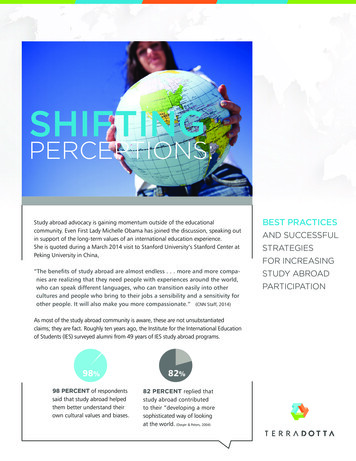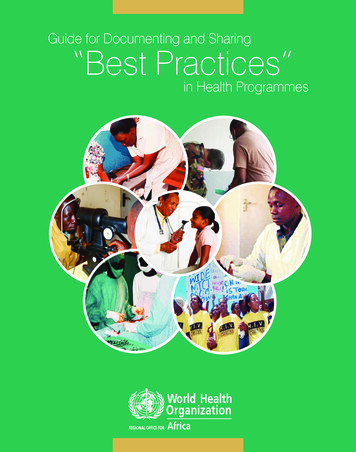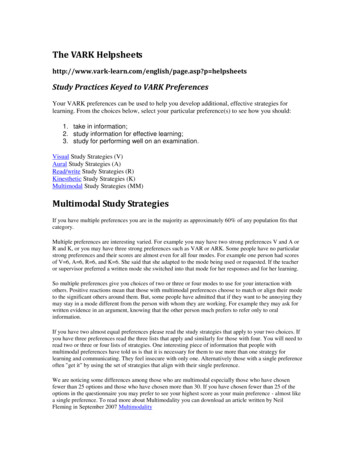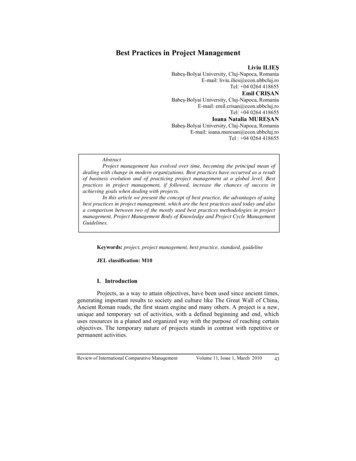
Transcription
SHIFTINGPERCEPTIONS:Study abroad advocacy is gaining momentum outside of the educationalcommunity. Even First Lady Michelle Obama has joined the discussion, speaking outin support of the long-term values of an international education experience.She is quoted during a March 2014 visit to Stanford University’s Stanford Center atPeking University in China,“The benefits of study abroad are almost endless . . . more and more companies are realizing that they need people with experiences around the world,who can speak different languages, who can transition easily into othercultures and people who bring to their jobs a sensibility and a sensitivity forother people. It will also make you more compassionate.” (CNN Staff, 2014)As most of the study abroad community is aware, these are not unsubstantiatedclaims; they are fact. Roughly ten years ago, the Institute for the International Educationof Students (IES) surveyed alumni from 49 years of IES study abroad programs.98%98 PERCENT of respondentssaid that study abroad helpedthem better understand theirown cultural values and biases.82%82 PERCENT replied thatstudy abroad contributedto their “developing a moresophisticated way of lookingat the world. (Dwyer & Peters, 2004)BEST PRACTICESAND SUCCESSFULSTRATEGIESFOR INCREASINGSTUDY ABROADPARTICIPATION
Although these benefits have been widely understoodwithin the international education community for years,it is encouraging to see the public support behind theinitiative. Study abroad participation has been steadilyincreasing, but the IIE’s 2013 Open Doors Report stillshows less than 10% participation among undergraduatesnationwide. (Institute of International Education, 2013)Each program is responsible for its own growth, butsharing best practices can help study abroad programsgrow more rapidly.IIE is doing its part to raise awareness through theGeneration Study Abroad initiative, challenging schoolsnationwide to double their study abroad participationrates by 2019.It will take widespread institutional involvement and anumber of small steps to make study abroad more affordable,accessible and attractive to a broader range of students.Generation Study Abroad initiative challenges schoolsnationwide to double study abroad participation rates by 2019.This article highlights ideas from representatives at Valparaiso University, Case Western Reserve University,Kansas State University, Western Illinois University, Elon University, and Miami University (Ohio)—all ofwhom have committed to Generation Study Abroad.OPENDOORSTHROUGH CURRICULAR INTEGRATIONRepresentatives from all six schools communicated thatthe more tightly woven study abroad options are into thecurriculum, the more likely students are to participate. Thereason? College is expensive. Many students and parents balkat the idea of adding undue time and money for courseworkthat does not count toward graduation requirements.“One of the biggest questions we get at the Office ofInternational Programs is, ‘When is the best time to goabroad?’” said Valparaiso University Director of StudyAbroad, Julie Maddox. “It is advantageous for the studentif those guidelines are already set within their specificmajor or department.”It is also important to proactively communicate with students so they know their available options and can plan theirpath to graduation accordingly.EXAMPLES OF CURRICULAR INTEGRATION IN ACTION:nKANSAS STATE UNIVERSITY—At Kansas State University, first-year students are encouraged to participate ininterest based learning communities—one of which has a study abroad element. Students meet in the fall for twointerrelated courses, each worth three credits. Coursework is capped off over winter break with a one-credit servicelearning trip to Costa Rica. K-State also has plans underway to offer “Minor Abroad” programs, during which studentscan earn the majority of their credits towards a minor during a term abroad.nCASE WESTERN RESERVE UNIVERSITY—At Case Western Reserve University, students have a number ofopportunities to turn their winter and spring breaks into intercultural learning experiences. Winter break programsenhance first semester courses, while spring break programs augment second semester courses.nMIAMI UNIVERSITY—Miami University’s Farmer School of Business offers a “China Business Program” as acomplement to its business major. Upon completion of the certificate program, which has an overseas study requirement,students receive a notation on their academic transcript identifying them to future employers as China business specialists.
ENGAGEFACULTY SUPPORTTrue curricular integration can only work with the supportof the faculty and department chairs, so it is important forstudy abroad professionals to do as much as possible togain their cooperation.Some best practices shared by our panel:nnnHost “Lunch and Learn Sessions”—The CaseWestern Reserve University Center for InternationalAffairs invites faculty into their offices regularly foran educational lunch series. They discuss variousinternational topics – from how to best supportinternational students on campus, to risk management.Provide Financial Support—According to CWRU’sStudy Abroad Advisor, Lisa Ann Brown, Case also “putstheir money where their mouth is,” with a faculty seedgrant initiative to assist faculty members who want todevelop new international initiatives.Build a Database—Miami University is in theprocess of building a database that can be shared withfaculty to help support a more coordinated effort ofinternational partnerships and agreements. The idea isthat if they are able to see existing connections, it willbe simpler to build on those than to start anew.INCREASEACCESSIBILITY“What does it mean to us to increase Study Abroad?” askedMiami University Associate Director of Global InitiativesKarla Guinigundo.“In some ways it means looking at new anddifferent ways to get students abroad—frommore service learning opportunities andinternships to an increasing array of facultyled programs.”Examples shared by our panel include:nnnnnnTRUE CURRICULARINTEGRATIONCAN ONLY WORKWITH THE SUPPORTOF THE FACULTYAND DEPARTMENTCHAIRS.Leveraging a formal 3-week winter term for shorterterm programs.Collaborating with the athletic department tocreate coordinated overseas learning, training, andcompetition opportunities for student-athletes.Reaching out to alumni and corporate partners tocoordinate international internships.Taking advantage of external programs like EngineersWithout Borders.Partnering with various departments on campus todevelop more non-traditional research, co-op andinternship programs abroad.Designing and publishing major specific pathways tostudy abroad and graduate on time.
MINIMIZETHE MARGINAL COSTSNo matter how many programs are out there, going overseas is not something everyone can afford without a littlehelp. Recognizing this, schools have chosen to attack this barrier in multiple ways.Here are a few of the courses of action suggested by our interview panel:INCREASE SCHOLARSHIPSnnnnnnnDedicate personnel to hunt down new avenues offunding.Actively solicit strategic corporate partnerships.Collaborate with the development department toincrease donor outreach.Pursue available grant funding.Engage alumni support.Build endowments to fund scholarships long term.Consider scholarships for freshman to start planting theseed early.PURSUE MORE FLEXIBLE FUNDINGnnnDevelop a loan program where students can borrowagainst their financial aid.Explore financial aid options that are not tied to FAFSAor donor requests.Assist students in pursuing merit-based opportunitiesthat aren’t tied to need.
COMBATMISPERCEPTIONSThere are students who think study abroad is tooexpensive, will never work with their major, or is justnot for people like them. These perceptions can only beaddressed through consistent focused outreach.Our interview panel shares their ideas.nnEngage on-campus alumni—“Students who havereturned from a trip abroad often want to share theirexperiences with others,” said Case Western ReserveUniversity’s Lisa Brown. “But they are not sure howto channel that energy. We are working on a way toorganize them so they can help support and mentorother students who are thinking of going abroad.”Leverage social media—“We have been usingsocial media to promote the idea of studying abroad,”said Western Illinois’ Emily Gorlewski. “It’s a simplething, but has taken off. We ask for student volunteersnnfrom our study abroad alumni, post a photo from whenhe or she was abroad, tag the student, and post it toour Facebook page. They don’t necessarily ’like’ ourpage, but they like their friends pages so because thestudents are tagged, their friends still see the posts.”Attack the issue with focused marketing—“Toreally change perceptions you need to engage studentsthrough focused marketing,” said Elon’s Woody Pelton.“Find out where the underrepresented students are andthen go there. Stapling the flyer on the dorm wall is notgoing to do it.”Actively promote scholarship opportunities—“We promote the Gilman Scholarship,” said MiamiUniversity’s Guinigundo. “It is a need-based studyabroad scholarship for Pell Grant recipients, that is oneof the best out there and can really help students in asignificant way.”CONCLUSIONWhile some of the program-specific ideas mentioned in this article, like Miami’sChina program, could be perceived as ground-breaking, most are just good ideasthat will take legwork and institutional involvement to implement.Michelle Obama called the benefits of study abroad “almost endless.” The sharingof industry best practices will make it possible to achieve the goals set by GenerationStudy Abroad, increase participation, and enhance the student experience.ABOUT TERRA DOTTAOur mission at Terra Dotta is to offer the very best products and services in higher education software. We are committed to delivering a user-experience thattransforms the way our clients operate and engage with their constituents. We accomplish this through the continual deployment of best-in-class technology,and the focus we place on mutual trust in each and every one of our business relationships. These values form the Terra Dotta difference.For additional information please visit www.terradotta.comResourcesCNN Staff. (2014, March 25). Michelle Obama’s reasons to study abroad. In CNN.com. Retrieved May 21, 2014, from amastudy-abroad-interview/Dwyer, M. M., & Peters, C. K. (2004, March). The benefits of study abroad. In Transitions Abroad. Retrieved May 21, 2014, from zine/0403/benefits study abroad.shtmlInstitute of International Education. (2013). Open Doors Report on International Educational Exchange. Retrieved from http://www.iie.org/opendoors
International Programs is, 'When is the best time to go abroad?'" said Valparaiso University Director of Study Abroad, Julie Maddox. "It is advantageous for the student if those guidelines are already set within their specific major or department." Generation Study Abroad initiative challenges schools











